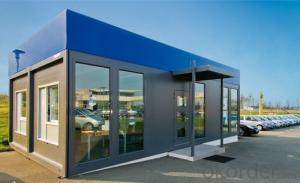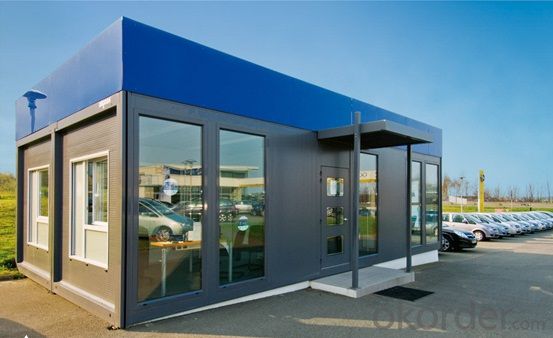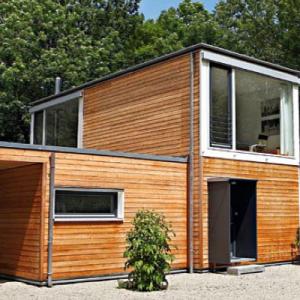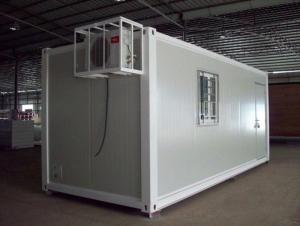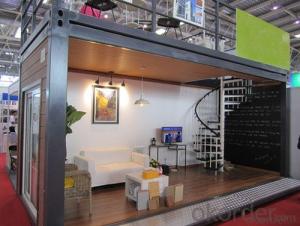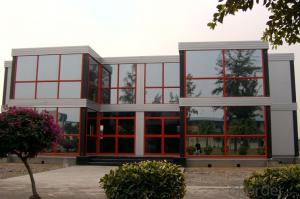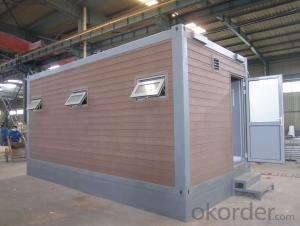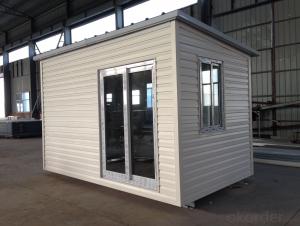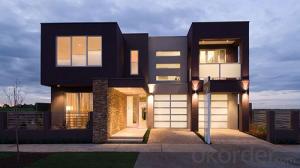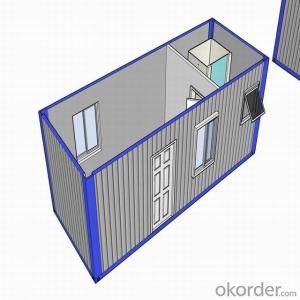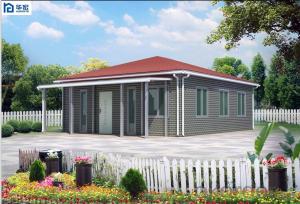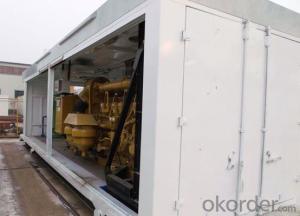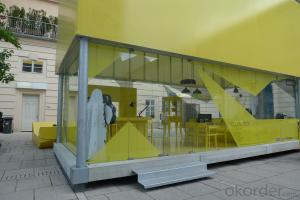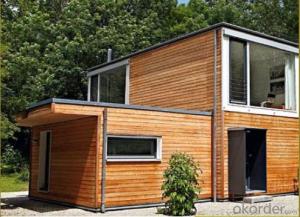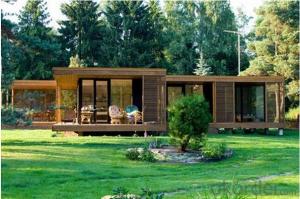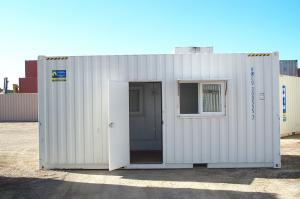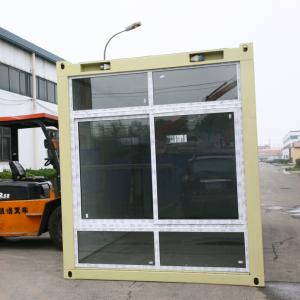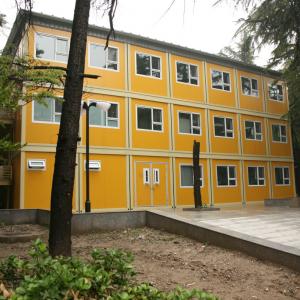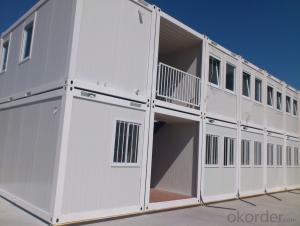Popular container house
- Loading Port:
- China Main Port
- Payment Terms:
- TT OR LC
- Min Order Qty:
- -
- Supply Capability:
- -
OKorder Service Pledge
OKorder Financial Service
You Might Also Like
Product:
20ft Container House,Movable House,Prefab House,Mobile House,Modular House,Low-cost Office,Toilet,Shower
Specification: 5910*2438*2591mm
No. | Part Name | Material |
1 | Foundation | Square Tube |
2 | Corner Post | Steel |
3 | Floor Beam | C Shape Steel |
4 | Roof Beam | C Shape Steel |
5 | Connection Plate | Steel |
6 | Edge Covering | Steel Plate |
7 | Wall | Sandwich Panel, optional |
8 | Flooring | Plywood+Vinyl Flooring/Laminate Flooring, optional |
9 | Roof | Corrugated Sandwich Panel, optional |
10 | Door | Sandwich Panel with aluminum doorframe |
11 | Doorlock | Stainless Steel |
12 | Window | Plastic Steel or Aluminum |
Plan:
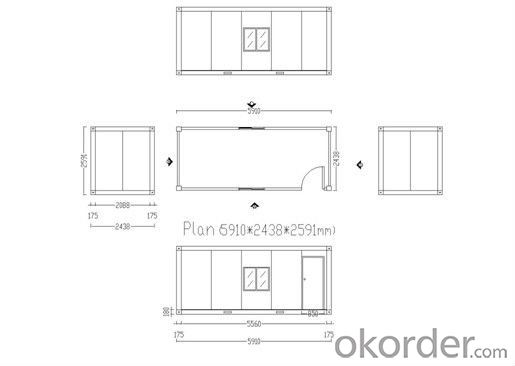
- Q: Are container houses earthquake-resistant?
- Yes, container houses can be earthquake-resistant when properly designed and constructed. The use of strong steel frames and reinforced foundation systems can enhance their structural integrity, making them more resilient to seismic activity. Additionally, the compact and modular nature of container houses allows for easier implementation of earthquake-resistant features, such as flexible connections and effective bracing systems. However, it is essential to ensure that the design and construction of container houses adhere to local building codes and standards to maximize their earthquake resistance.
- Q: How do container houses compare to traditional houses in terms of durability?
- Durability sets container houses apart from traditional houses. Typically, traditional houses are constructed using materials like bricks, concrete, and wood, known for their ability to withstand various weather conditions and endure for decades. Conversely, container houses are built using repurposed shipping containers primarily intended for transporting goods, rather than providing long-term accommodation. Although container houses are often fortified with additional structural elements during conversion, they may still be more vulnerable to wear and tear compared to traditional houses. Factors such as corrosion, rusting, and damage to the container's original structure can potentially compromise the overall durability of a container house. Nevertheless, it is crucial to acknowledge that durability can vary depending on the construction quality and materials used in both traditional houses and container houses. For instance, a well-designed and properly constructed container house can offer comparable durability to a traditional house, especially when built with high-quality materials and subject to regular maintenance. Additionally, container houses possess the advantage of being pest-resistant, owing to their steel structure. This attribute contributes to their longevity in contrast to traditional houses, which may necessitate regular pest control measures. To conclude, while traditional houses boast a proven track record of durability, container houses can also provide a resilient living space if constructed with high-quality materials and given proper maintenance. Ultimately, the specific design, construction, and maintenance approaches employed in each case determine the level of durability offered.
- Q: Can container houses be designed to have a small ecological footprint?
- Yes, container houses can definitely be designed to have a small ecological footprint. One of the major advantages of using shipping containers for housing is that they are already made from recycled materials, reducing the need for new resources. Additionally, container houses can be designed with various eco-friendly features to minimize their environmental impact. Firstly, insulation can be added to the container walls, floors, and roofs to improve energy efficiency and reduce heating and cooling needs. This can be achieved by using materials such as spray foam insulation or recycled materials like cellulose insulation. Secondly, container houses can incorporate renewable energy sources to further reduce their ecological footprint. Solar panels can be installed on the roof to generate electricity, reducing reliance on the grid and decreasing carbon emissions. Additionally, rainwater harvesting systems can be implemented to collect and store rainwater for various uses, such as irrigation or flushing toilets, reducing the demand for freshwater resources. Furthermore, container houses can be designed with sustainable and eco-friendly materials, such as reclaimed wood or bamboo flooring, low VOC (volatile organic compound) paints, and energy-efficient appliances and fixtures. By utilizing these materials, the overall environmental impact of the house can be minimized. Lastly, container houses can be designed to be space-efficient, maximizing the use of the available area. This can include incorporating multifunctional furniture or utilizing vertical space for storage, reducing the overall footprint of the house and potentially allowing for smaller land usage. In conclusion, container houses can indeed be designed to have a small ecological footprint. By incorporating insulation, renewable energy sources, sustainable materials, and space-efficient design, container houses can significantly reduce energy consumption, carbon emissions, and overall environmental impact.
- Q: Are container houses suitable for guest houses?
- Indeed, guest houses can certainly benefit from the use of container houses. The popularity of container houses continues to rise due to their affordability, sustainability, and versatility. These structures are constructed from repurposed shipping containers, which makes them a cost-effective choice for guest accommodations. Guest houses can be tailored to meet specific requirements using container houses. They can be designed to include all essential amenities such as bedrooms, bathrooms, kitchens, and living areas. Moreover, they can be modified to provide a pleasant and practical living space for guests. Furthermore, container houses possess the advantage of being portable, allowing for easy relocation if necessary. This flexibility permits homeowners to move the guest house to different parts of their property or even take it with them if they decide to relocate. Additionally, container houses are environmentally friendly. By utilizing repurposed shipping containers, these structures contribute to waste reduction and the promotion of sustainability. In an era where environmental consciousness is increasing, many guests appreciate staying in accommodations that prioritize sustainability. To sum up, container houses are undeniably suitable for guest houses. They offer affordability, versatility, and sustainability, making them an appealing choice for homeowners seeking to create comfortable and functional guest accommodations.
- Q: Can container houses be designed with a home workshop or craft space?
- Yes, container houses can definitely be designed with a home workshop or craft space. One of the main advantages of container houses is their versatility and flexibility in design. With proper planning and layout, it is possible to incorporate a designated area for a home workshop or craft space within the structure of a container house. Container houses can be modified and customized to cater to specific needs and preferences. The interior layout can be designed to include a separate room or section that can serve as a workshop or craft space. This area can be equipped with workbenches, storage shelves, tool racks, and other necessary equipment based on the specific requirements of the homeowner. Some container houses even feature double-height ceilings, which can be advantageous for accommodating larger equipment or machinery. The containers can be interconnected or expanded to create a larger workspace if needed. Windows and skylights can be strategically placed to allow ample natural light into the workshop or craft space, enhancing productivity and creativity. Additionally, container houses are known for their energy efficiency and insulation properties. This ensures a comfortable working environment, regardless of the weather conditions outside. Proper insulation, ventilation, and heating or cooling systems can be installed to maintain suitable temperatures and airflow within the workshop or craft space. In conclusion, container houses can be designed with a home workshop or craft space, making them an excellent choice for individuals who want to combine their living space with their hobbies or professions. The design possibilities are vast, and with careful planning and customization, a container house can provide a functional and inspiring workspace for creative pursuits.
- Q: Are container houses sustainable?
- Yes, container houses can be sustainable. They are built using recycled shipping containers, which reduces the use of new materials and minimizes waste. Additionally, the compact size of container houses promotes energy efficiency and reduces carbon footprint. They can also be designed with eco-friendly features such as solar panels, rainwater harvesting systems, and green roofs, further enhancing their sustainability.
- Q: Can container houses be designed to have a home theater?
- Certainly! Container homes are incredibly versatile and can easily be tailored to include a home theater. These homes offer limitless possibilities for customization, allowing you to meet your specific needs and desires. By carefully planning and designing, it is completely feasible to integrate a home theater into a container home. Firstly, the dimensions of the containers can be adjusted to create ample space for a home theater. You can connect or stack containers to expand the living area, providing a dedicated room for your theater. Furthermore, the internal layout can be personalized to include raised flooring for seating, soundproofing materials for improved acoustics, and specialized lighting to create a cinematic ambiance. In addition, container homes can be equipped with all the necessary technology for a superb home theater setup. This entails installing a large screen or projector, surround sound speakers, and cozy seating. The electrical and wiring systems can be expertly designed to support the audio-visual equipment and ensure seamless connectivity. It is crucial to consider the thermal and insulation requirements of a container home to guarantee optimal comfort. To create a cozy atmosphere for movie nights and entertainment, appropriate insulation and climate control systems can be incorporated. Ultimately, container homes offer exceptional design flexibility and can be personalized to perfectly suit your preferences, including the inclusion of a home theater. With meticulous planning, innovative design solutions, and the right technology, container homes can provide an unparalleled and enjoyable cinematic experience right at your fingertips.
- Q: Are container houses suitable for senior living communities?
- Yes, container houses can be suitable for senior living communities. These houses are often designed to be accessible and can be modified to meet the specific needs of seniors, such as incorporating ramps, grab bars, and wider doorways. Container houses are also cost-effective, energy-efficient, and can be easily customized to create comfortable and safe living spaces for seniors.
- Q: Can container houses be designed to have a small balcony or terrace?
- Yes, container houses can definitely be designed to have a small balcony or terrace. With proper planning and structural modifications, containers can be transformed to include outdoor spaces such as balconies or terraces, providing additional living areas and enhancing the overall functionality and aesthetics of the container house.
- Q: Can container houses have a traditional interior design?
- Yes, container houses can have a traditional interior design. The interior design of a container house can be customized to fit any style, including traditional. By incorporating traditional furniture, decor, and finishes, container houses can create a cozy and traditional living space while still maintaining their unique architectural features.
Send your message to us
Popular container house
- Loading Port:
- China Main Port
- Payment Terms:
- TT OR LC
- Min Order Qty:
- -
- Supply Capability:
- -
OKorder Service Pledge
OKorder Financial Service
Similar products
Hot products
Hot Searches
Related keywords
